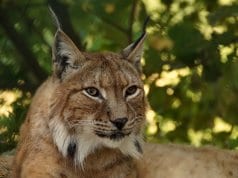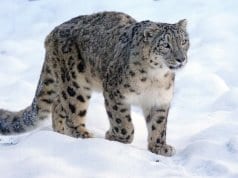Cuyabeno National Park is one of the dozens of national parks located in the Amazon Basin. However, unlike many of the regions other protected parks, Cuyabeno is located in Ecuador, near the foothills of the Andes Mountains. This means the park’s climate is milder than many other Amazonian parks. It also means the park offers visitors the chance to see unusual habitats and the wildlife that inhabit them.
We’ll discuss some of the most notable wildlife species living within the park below and provide some tips for seeing as many different creatures as you can during your visit. This way, you can make the most of your Cuyabeno adventure and ensure that it is the trip you’ll never forget.
Large Mammals of the Region
A variety of large mammal species call Cuyabeno National Park home.
The mammals living in Cuyabeno National Park are quite spectacular, and all visitors will want to try to see as many different species as possible during their visit. You won’t have a chance to see all of the park’s mammalian ambassadors. However, a few of the most commonly seen species include white-tailed and brocket deer, as well as sloths and monkeys.

A few large mammalian predators also live within Cuyabeno National Park. Jaguars and pumas are the two largest predators in the park. However, ocelots also hunt amid the rainforest floor. Additionally, a variety of rainforest-dwelling rodent species are also commonly seen by visitors.
And although Cuyabeno National Park is most noted for its terrestrial animals, there are many interesting aquatic species living in the park too. Capybaras – the world’s largest rodents – are common in the park, and they usually hang out near river and lake borders. Manatees are also common, and they’re usually easy to see while paddling down the local rivers.
Birds of Cuyabeno National Park
The bird life of Cuyabeno is quite spectacular and visitors will certainly want to see as many species as possible.
Like many other rainforest-covered parks, Cuyabeno National Park is full of beautiful and interesting bird species, you’ll want to see during your visit. There are nearly 600 species living in the park, including several who are endemic to the area.

A few of the most notable species include the squirrel cuckoo, greater ani and gilded barbet. All three species can be seen in the canopy of the Cuyabeno rain forest, and they’re regularly seen by park visitors. Several woodpeckers also call the park home. This includes large species, such as the crimson-crested woodpecker, and smaller species, such as the chestnut woodpecker.
A number of toucans – including the beautiful white-throated toucan – call Cuyabeno National Park home. Several parrots and macaws also live in the region, including the blue and gold macaw, the blue-headed parrot, and the orange-cheeked parrot.
Reptiles of the Rainforest
A number of reptiles – including a few dangerous species – inhabit Cuyabeno National Park.
Rainforests usually host a variety of reptile species, and Cuyabeno is no exception. A number of lizard species call the park home. This includes yellow-tongued anoles, who inhabit the forest’s trees, and yellow-bellied arthrosauras who spend their time scurrying through the leaf litter.

However, it is the park’s snake species that draw the most attention from visitors. Cuyabeno is not only home to an assortment of small lizard- and frog-eating species, it is also home to a variety of snakes that reach very large sizes and feed on big prey.
Rainbow boas, for example, grow to 7 feet in length and feed on rodents and lizards found on the forest floor. Boa constrictors reach larger sizes (up to 12 feet) and occasionally feed on prey as large as sloths and monkeys. However, the most impressive snake to call Cuyabeno National Park home is undoubtedly the green anaconda. Reaching more than 20 feet in length, these large, aquatic serpents hunt prey as large as caiman and capybara.
Wildlife Viewing Tips
Employ the following tips to help make your Cayabeno adventure unforgettable.
It can be challenging to reach Cuyabeno National Park. So, you’ll want to make sure that you see as many wild animals as possible to make your trip worthwhile. Fortunately, by embracing the tips and tricks described below, you should be able to see a variety of creatures as they go about their daily lives.
- Bring a flashlight. Even though you’ll be spending most of your time in Cayabeno exploring during the daytime, the rainforest is a very dark habitat. But, by bringing along a flashlight, you’ll be able to illuminate some of the cracks and crevices where secretive species spend most of their time.
- Binoculars are extremely helpful. If you want to see a variety of bird species while visiting Cayabeno, you’ll need to have a good pair of binoculars with you. Binoculars will not only help you spot birds that are hiding in the canopy above, but they’ll also help you see species that don’t allow you to approach very closely.
- Insect repellent will make the trip more enjoyable. Rainforests are full of biting bugs, including mosquitos, ticks and a number of flies. These bugs can not only transmit very serious diseases, but they’ll also often cause you so much frustration that you’re unable to focus on observing wild animals. Accordingly, bring and use a potent insect repellent. This will help you concentrate on seeing wildlife, rather than swatting at flies.
- Ask the park staff for tips. The staff working at Cayabeno National Park are very familiar with the animals living within the park borders. This means they can provide very helpful advice to visitors. So, be sure to ask the staff about places that normally harbor a number of different species. Ask them about the best time of day to check these places out too.

Share Your Experiences!
In many ways, Cuyabeno National Park is a one-of-a-kind destination that is sure to provide you with plenty of wildlife-viewing opportunities. There are a lot of national parks in and around the Amazon Basin. But if you are planning on visiting the region, you should definitely consider making Cuyabeno National Park one of the places you visit.
Have you ever been to Cuyabeno? We’d love to hear about your experiences. Tell us about the wildlife you observed and anything else you remember from the trip in the comments below.






![Red Angus Closeup of a beautiful Red Angus cowPhoto by: U.S. Department of Agriculture [pubic domain]https://creativecommons.org/licenses/by/2.0/](https://animals.net/wp-content/uploads/2020/03/Red-Angus-4-100x75.jpg)

